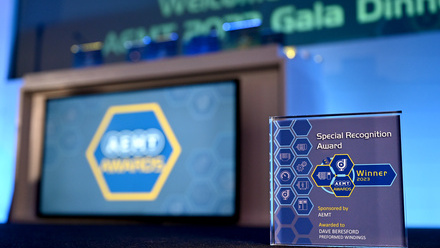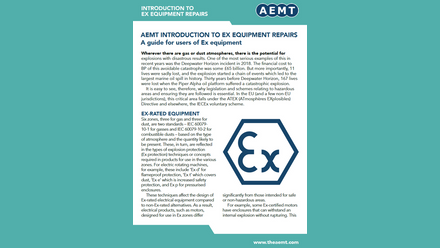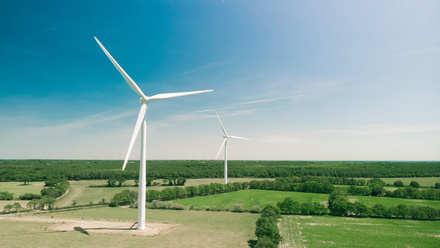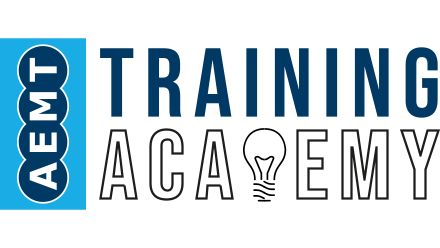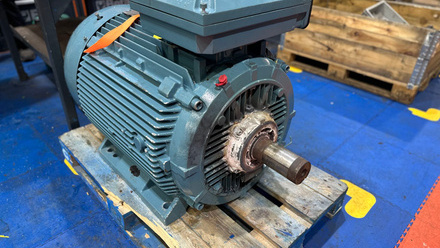The Repair Sector Delivers
Chris Callander explores the broad scope of work and the considerable impact the Association's membership has achieved.
Every day, AEMT members keep factories online, water and electricity flowing, transport moving, and so much more. Reviewing the entries for the annual Project of the Year award is an excellent opportunity to gain a deeper understanding of the impact the Association's members have made.
This year, the seven finalists drove the use of renewable energy through innovative engineering projects in the UK, Germany, Spain, Asia, and America. They implemented flood defences to protect the lives of 30 million people living below sea level. They regenerated the drinking supply of three million people across 250 cities. Across just two projects, the finalists achieved a reduction of CO2 emissions by 2,500 tonnes a year. They also enabled hydropower to power an additional 16.500 homes. And in Spain, one member made the irrigation of 3,000 hectares of farmland possible, which helped to yield more profitable farming and could help to reduce the price of your weekly shop.
When you consider there are hundreds of AEMT members carrying out projects like these every day, it's easy to see how important the electromechanical repair sector is.
MKE – BROWNDOWN PUMPING STATION
The project which came out as the winner among the seven finalists in the 2023 AEMT Project of the Year award was the upgrade of the Browndown Pumping Station, part of the Southern Water network, which was carried out by Mid-Kent Electrical.
The pumping station was experiencing frequent tripping of equipment, raising concerns over the site's resilience and its ability to meet the required consent.
The station's three main two-speed pump motors – which dated back to the late 1970s – ran on star delta starters and were believed to be the cause of the rogue tripping. Data collected by MKE showed that these large 180/355kW motors were showing excessive starting currents, notably peaking instantaneously at more than 4000A when starting at high speed.
The site was running each pump approximately three times per hour, with each start requiring vast amounts of energy, but it was also found to be causing surges of transient pressure in the associated pipework and inconsistent flows to the treatment works further down the system.
Converting the site to variable speed control was considered critical to stop the tripping and reduce wasted energy, improve operations and, ultimately, reduce the pumping station's carbon footprint.
The newly installed system included all new IE4 ABB motors coupled with ultra low harmonic ABB variable speed drives. This provided the ability to increase efficiency and resilience with a very short payback time. The original motor bedplates were replaced with bespoke units, manufactured and machined in-house by MKE, keeping downtime for each pump to a minimum.
The project initially aimed to alleviate the tripping issues but with the added benefit of improving site efficiencies. Since the installation, the rogue tripping issues have been resolved, and significant improvements in operation have been observed. Energy consumption has also been greatly reduced, and in turn, this has helped to limit the site's carbon footprint.
Energy monitoring has shown that since the upgrade, the site is saving over £55,000 per year with an estimated reduction in its carbon footprint of around 145 tonnes each year.
ABB – THE LISTER DRIVE GREENER GRID PROJECT
The UK's drive to reduce carbon dioxide emissions and minimise climate change is driving the increased use of renewable energy. The challenge is that wind and solar energy sources use power conversion technologies that do not provide the inertia grid operators rely on to maintain grid stability.
ABB synchronous condensers offer a solution. They are large rotating machines developed to mimic the operation of coal or gas-fired generators by providing an alternative source of spinning inertia. They support the national grid by providing reactive power compensation and additional short-circuit power capacity, allowing more renewables to be connected to the grid.
The Lister Drive project is the first installation of ABB's synchronous condensers in England. It is also the first project worldwide to feature a high-inertia configuration. This couples a 67 megavolt amps reactive (MVAr) synchronous condenser with a 40-tonne flywheel, increasing the instantaneously available inertia by 3.5 times.
The high-inertia system will ensure that the network frequency and voltage are held stable within the tight limits essential to maintain grid reliability.
The project, which included all necessary components to make it a turn-key install and includes ongoing planned and quick-response maintenance support, will play a key role in stabilising the local grid to handle an increased amount of wind and solar power. This will help National Grid meet its target of operating a zero-carbon electricity system by 2025.
BEDFORD PUMPS – JAKARTA URGENT FLOOD MITIGATION
In collaboration with its sister company, Avonmouth Engineering Services, Bedford Pumps has fulfilled a project to supply eight submersible axial flow, fish-friendly pumps to Indonesia as part of the Jakarta Urgent Flood Mitigation Project.
The company's first order into the region has provided two pumping stations, Kamal and Sentiong, with the capacity to withdraw water from drains in subsided areas where gravity is no longer suffi cient, helping to protect the flood-prone city.
The 1600mm diameter, 25-tonne axial flow pumps are the largest submersible pumps installed in southeast Asia and the largest manufactured by Bedford Pumps. Their installation provides flood protection for one of the most populated cities in the world. Inhabitants currently stand at 30 million, which has soared from just 540,000 in the 1940s. The environmental and social conditions of inadequate drainage and infrastructure through rapid urbanisation, combined with Jakarta's location in a lowland delta area, have left the city frequently plagued by floods.
It is estimated that close to 40% of Jakarta is currently below sea level, with models predicting that this could rise to 95% by 2050. With the Java Sea to the north and 13 rivers flowing through the city from the mountains to the south, without projects such as this, the consequences for the inhabitants of the city would have become dire.
Each pump will pass 10,000 litres per second of brackish river water at 5m head. The pumps are rated at 700kW and designed to provide enhanced life, lower maintenance costs, improved solids handling and market leading hydraulic effi ciency, resulting in the lowest total cost of ownership.
HOUGHTON INTERNATIONAL - ONSHORE WIND TURBINE LIFEEXTENSION PROJECT
This project undertaken by Houghton International addressed critical challenges faced by SEV, the owner and operator of the Neshgashi wind farm in the Faroe Islands. The aim was to extend the lifespan of an onshore Enercon E44 wind turbine that was experiencing premature failure due to the harsh weather conditions unique to the location.
Houghton International's team executed a complete rewind of the 16-tonne direct drive generator, upgrading the stator windings with higher grade copper covering, an improved insulation system, and a superior varnishing system.
The design for the rotor field coils was upgraded with a class H covering, the application of vacuum impregnation resin and increased mechanical strength to the coil former. Additionally, an examination of the hub led to the replacement of the pitch motors and one bearing, ensuring optimal functionality and safety.
Addressing the premature failure of the turbine supports a continuous and sustainable energy supply for the island, aligning with the Faroe Islands' commitment to rely solely on renewable energy by 2030.
MENZEL GB – PUMP MOTOR WITH BRUSH-LIFTING DEVICE
This major Government-funded utility project supported the regional drinking water supply in Germany for approximately 250 cities and communities with around three million inhabitants. The existing motor at the heart of the pumping systems, built in 1969, was still operating but had long surpassed its original intended life span and desperately needed replacement.
The tender called for all requirements to be met by a single source and called for a slip-ring brush lifting device to be mounted on the motor. Where a slip ring or wound rotor motor is a requirement, a brush lifting device is always used when the motor starts only once and then runs for a long time. This prevents the brushes from permanently being in contact with the slip ring surface, suffering from excessive wear and contaminating the slip ring space with the brush abrasion. Installing a brush lifting device on a relatively large slip ring motor (frame size 800) meant the device had to be procured, adapted and installed on the motor in Menzel's workshop.
All system components were supplied by Menzel and assembled and commissioned on site, with the old motor removed for disposal.
PREFORMED WINDINGS – PROJECT HOLTER
A five-year project that started in 2021, project Holter aims to increase the efficiency of seven generators installed on the Holter Dam, which is in the Missouri River, USA. Doubling hydropower capacity by 2050 is a crucial factor in meeting the Paris climate targets.
However, many existing hydro facilities in the US and Europe are old, and there are few options to build new ones. The answer is to refurbish existing facilities to make them more efficient, increase output, and increase their lifespan, all while reducing maintenance requirements.
In collaboration with Sidewinders LLC, a hydro repair specialist, Preformed Windings was challenged to increase the output capability of each hydro generator by 50% while extending the asset's life and reducing maintenance requirements. This target was successfully achieved using the company's QualCoil-Hydro specification of HV coil specifically developed to last decades with minimal maintenance.
Once all seven generators have been refurbished, annual generation should increase from 350,000,000 KWh to over 500,000,000 kWh, which is enough to power an additional 16,500 homes and businesses with renewable energy. And of course, the CO2 savings from creating this additional energy from renewable sources instead of fossil fuels is massive.
SULZER – MEMBRANE FEED PUMPS FOR A DESALINATION PLANT
Faced with declining groundwater sources, a large water management company in Spain initiated a project to reactivate a mothballed desalination plant in the Gulf of Almeria.
To manage the plant's significant energy cost, Sulzer worked closely with the management company to retrofit the existing high-pressure pumps, which were initially from another OEM. Through this reengineering, Sulzer was able to maximise operational efficiency and significantly reduce the plant's energy requirements.
Starting without any engineering drawings for reference, the engineering team faced the challenge of reverse-engineering the existing pressure casing and rotor assembly and designing a new low-flow rotor assembly to meet updated specifications. The objective was to ensure the pumps operated at their best efficiency point (BEP). Meticulous attention to detail ensured the new rotor assembly was fully interchangeable with the existing casing, mechanical seals, bearing assemblies, and coupling. Moreover, the pump casings were modified slightly to improve their longevity and hydraulic performance.
The redesigned pumps now operate at nearly half their original flow rate, yet with efficiency gains of over ten percentage points – translating into substantial financial savings and environmental benefits. The new pumps consume almost 1,000kW less than the original units. The plant's operators, have also seen a significant reduction in operational costs and a marked cut in the carbon footprint, amounting to 2,345 fewer tonnes of CO2 emitted annually.

